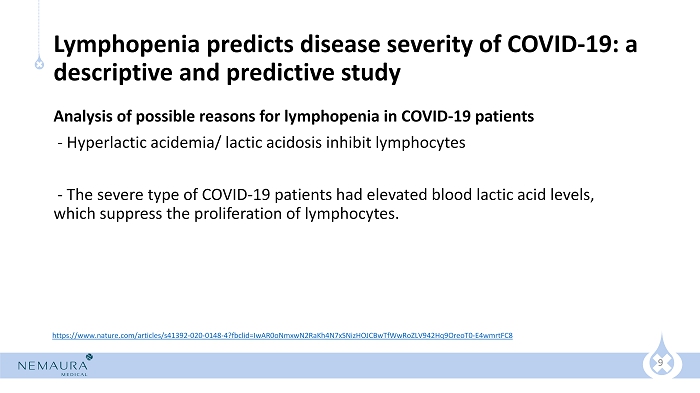Attached files
| file | filename |
|---|---|
| EX-99.1 - EXHIBIT 99.1 - Nemaura Medical Inc. | ex99x1.htm |
| 8-K - FORM 8-K - Nemaura Medical Inc. | nmra_8k.htm |
Exhibit 99.2

Better Diagnostics for Life BEAT™ Continuous non - invasive Lactate Monitoring In Critical Care and Monitoring Disease Progression in Covid - 19 July 2020

2 Author Dr Moiz Khan, Pharm.D , MBA

3 Overview Continuous Lactate monitoring has Potential in Medical and non Medical Applications. Medical Field - Recent reports of elevated Lactate levels in Covid - 19 patients - Critical Care monitoring Non - Medical Field - Athletic performance monitoring/endurance training This presentation highlights the potential applications of Continuous Lactate Monitoring in Critical Care, and monitoring disease progression in Covid - 19 patients Nemaura’s CLM (Continuous Lactate Monitoring) device is based on the BEAT™ platform used in sugarBEAT®, with appropriate adaptations to the sensor chemistry, the algorithm and the mobile app interface. Nemaura is evaluating the timelines for bringing this product to market as a Class 2 approved medical device.

4 Increased blood lactate levels: a marker of critical disease states Normal blood lactate levels are 1.3 mmol /L . Lactate metabolism mainly occurs in the liver and kidney. Increased lactate levels have been consistently associated with morbidity and mortality in a wide range of disease states for many years. Increased blood lactate levels, in combination with acidosis, should urge the clinician to restore a probable imbalance between oxygen demand. Increased blood lactate levels should prompt the clinician to initiate both diagnostic and immediate therapeutic actions and intensive care admission should be considered. https://acutecaretesting.org/en/articles/increased - blood - lactate - levels - a - marker - of

5 Clinical use of lactate monitoring in critically ill patients Increased blood lactate levels ( hyperlactataemia ) is common in critically ill patients. Lactate levels are frequently used to diagnose inadequate tissue oxygenation, and other processes not related to tissue oxygenation may also increase lactate levels. Increased lactate levels usually reflect increased morbidity and high mortality. Two multicentre trials suggest that the use of lactate levels in goal - directed therapy may improve clinical outcome. Findings confirm that lactate monitoring is a valuable parameter in the early resuscitation of critically ill patients. https://www.ncbi.nlm.nih.gov/pmc/articles/PMC3654944/

6 Clinical applications of lactate testing in patients with sepsis and septic shock Hyperlactatemia is very common in patients with sepsis and septic shock and is closely associated with poor prognosis. The third international consensus definition for sepsis and septic shock recently revised the definition of septic shock. Serum lactate concentration >2 mmol /L was added as a key component in the definition of septic shock. The Surviving Sepsis Campaign (SSC)recommended lactate normalization in patients with elevated lactate levels as a marker of tissue hypoperfusion http://jeccm.amegroups.com/article/view/4083/4694

7 Covid - 19: A retrospective review of medical records in a single medical centre, Wuhan, China https://www.sciencedirect.com/science/article/pii/S1201971220301867

8 Covid - 19: A retrospective review of medical records in a single medical centre, Wuhan, China https://www.sciencedirect.com/science/article/pii/S1201971220301867

9 Lymphopenia predicts disease severity of COVID - 19: a descriptive and predictive study Analysis of possible reasons for lymphopenia in COVID - 19 patients - Hyperlactic acidemia / lactic acidosis inhibit lymphocytes - The severe type of COVID - 19 patients had elevated blood lactic acid levels, which suppress the proliferation of lymphocytes. https://www.nature.com/articles/s41392 - 020 - 0148 - 4?fbclid=IwAR0oNmxwN2RaKh4N7xSNizHOJCBwTfWwRoZLV942Hq9OreoT0 - E4wmrtFC8

10 Epidemiologic and clinical characteristics of 91 hospitalized patients with COVID - 19 in Zhejiang, China: a retrospective, multi - centre case series https://academic.oup.com/qjmed/article/113/7/474/5809152

11 Conclusions Increase in blood lactate levels is a marker of critical disease states. Recent publications have indicated the presence of elevated lactate levels in patients with Covid - 19 infection. Continuous Lactate Monitoring therefore has applications in disease states including the monitoring of disease progression in Covid - 19 infections.
